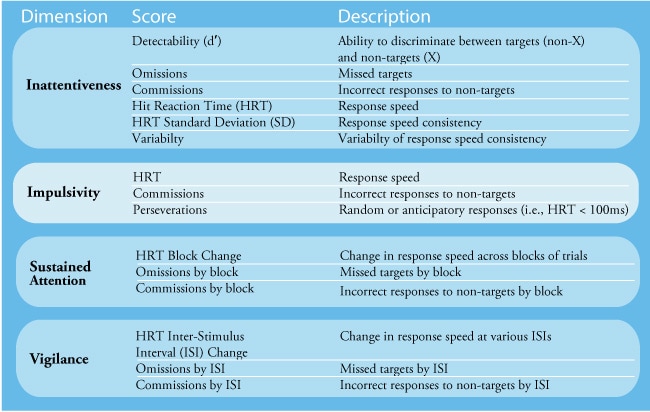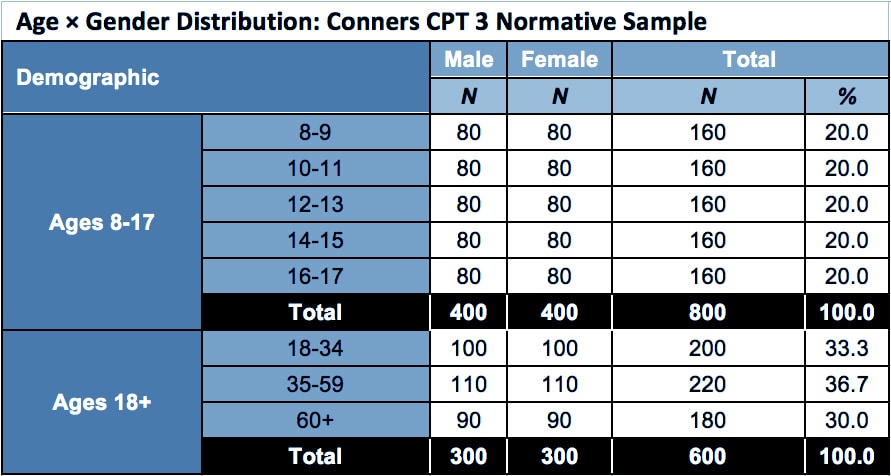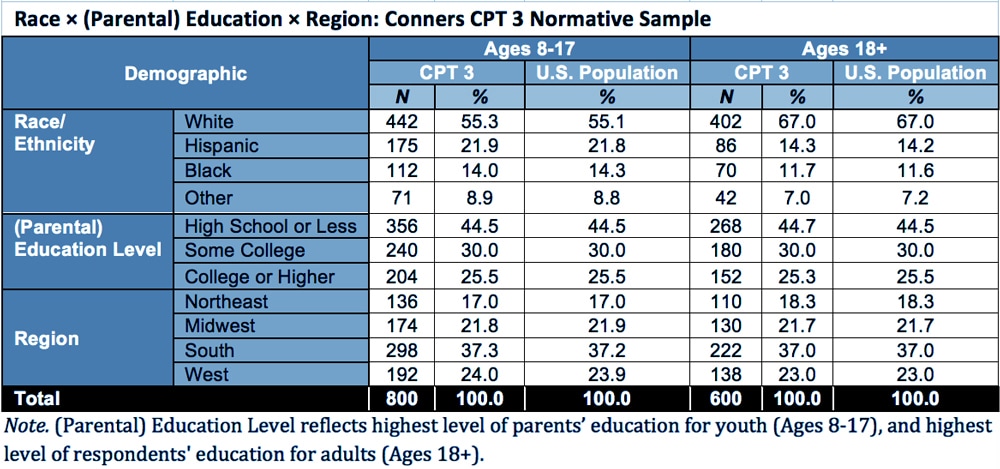The Conners Continuous Performance Test Standard Scoring
| The Conners Continuous Performance Test 3rd Edition™ (Conners CPT 3™) is a task-oriented computerised assessment of attention-related problems in individuals aged 8 years and older. By indexing the respondent's performance in areas of inattentiveness, impulsivity, sustained attention, and vigilance, the Conners CPT 3 can be useful to the process of diagnosing Attention-Deficit/Hyperactive Disorder (ADHD) and other neurological conditions related to attention. The Conners CPT 3 provides objective information about an individual's performance in attention tasks, complementing information obtained from rating scales such as the Conners 3. The Conners CPT 3 can be used in conjunction with the Conners Continuous Auditory Test of Attention ™ (Conners CATA™) which assesses auditory processing and attention-related problems in individuals aged 8 years and older. The Conners CPT 3 and Conners CATA can be purchased as a combo kit or individually. Click here to learn more about the Conners CATA.
New to the Conners CPT 3:
How to Use the AssessmentDuring the 14-minute, 360-trial administration, respondents are required to push the spacebar when any letter, except "X", appears. The Conners CPT 3 is available as an unlimited use program. The number of computers that can use the program is limited to the number of installations purchased. Scoring and InterpretationNew scores and scoring algorithm have been developed to help assessors pinpoint the exact nature of the respondent's attention problems. The Conners CPT 3 uses both standardized and raw scores to determine not only the respondent's performance overall but also in four different aspects of attention: Inattentiveness, Impulsivity, Sustained Attention and Vigilance. The Most Representative CPT Normative Samples CollectedThe new normative sample consists of 1,400 cases and is representative of the United States (U.S.) population in terms of key demographic variables such as gender, race, geographical region, and parental education level. ReliabilityUsers can be confident that the Conners CPT 3 will yield consistent and stable scores across administrations. Internal ConsistencyOne measure of a test's internal consistency is split-half reliability, which has been previously used to establish the reliability of other continuous performance tests. Split-half reliability estimates of the Conners CPT 3 scales were calculated for the normative and clinical samples. Results were very strong – across all sccores, the median split-half reliability estimate was .92 for the norm samples, and .94 for the clinical samples (all correlations were significant, p < .001). These results indicate that the Conners CPT 3 demonstrates excellent internal consistency for both the normative and the clinical groups. Test-Retest ReliabliltyTest-retest reliability refers to the consistency of scores obtained from the same respondent on separate occasions over a specified period of time. To estimate the test-retest reliability of the Conners CPT 3, a sample of 120 respondents from the general population completed the Conners CPT 3 twice with a 1- to 5-week interval between administrations. The median test-retest correlation was .67. These results suggest a good level of test-retest reliability. ValidityUsers can be assured that the Conners CPT 3 will help detect attention deficits and differentiate Clinical from Non-Clinical Cases. Discriminative ValidityDiscriminative validity pertains to an instrument's ability to distinguish between relevant participant groups (i.e., the test's ability to differentiate between clinical and non-clinical groups). In order to conduct discriminative validity analyses, Conners CPT 3 data were collected during the standardization process from 346 children and adults who had an existing ADHD diagnosis. Conners CPT 3 scores from this ADHD sample were compared to a matched sample from the general population. Results indicated that significant differences were found between the ADHD sample and the matched general population sample on most measures with small to moderate effect sizes (d = 0.10 to 0.49). As expected, the ADHD sample performed more poorly (i.e., they had higher scores on the Conners CPT 3). In particular, the ADHD sample had lower d' scores, indicating more difficulty in distinguishing between relevant stimuli and distractors. Similarly, the ADHD sample made a greater number of errors (i.e., they had higher percentages of Omissions, Commissions and Perseverations than did the general population sample) and showed more variability in their responses overall (i.e., higher HRT SD scores) and across subblocks (i.e., higher Variability scores) compared to the matched sample of general population. The responses of the ADHD sample were also affected more by changes in block and ISI (i.e., higher HRT Block Change and HRT ISI Change scores). Incremental ValidityAnother approach in establishing the Conners CPT 3's validity is to show how it works together with other measures of similar constructs in the assessment of attention problems. To assess such validity, samples were collected in which cases were scored on the Conners CPT 3 and another measure of attention. Specifically, in a sample of 112 non-clinical and ADHD youths, parent-reports on the Conners 3rd Edition (Conners 3-P; Conners, 2008) were collected in addition to their scores on the Conners CPT 3. In a second sample of 137 non-clinical and ADHD adults, self-reports on the Conners Adult ADHD Rating Scales (CAARS; Conners, Erhardt, & Sparrow, 1999) were collected in addition to their scores on the Conners CPT 3. Logistic regressions were conducted in order to determine how well scores from the Conners CPT 3 improve the diagnostic efficacy of the rating scales in predicting group membership into ADHD or general population groups. For youth, when the Conners 3-P and Conners CPT 3 scores were considered together, there was an overall correct classification rate (i.e., the ability to accurately predict group membership) of 88.4%, sensitivity (i.e., the ability to correctly detect ADHD cases) of 89.5%, and specificity (i.e., the ability to correctly detect general population cases) of 87.3%. These values were 4.5%, 3.5%, and 5.5%, respectively, higher than when the rating scale was used on its own. For adults, when the CAARS and Conners CPT 3 scores were considered together, the overall correct classification rate was 92.7%, sensitivity was 73.1%, and specificity was 97.3%. These values were 3.6%, 7.7%, and 2.7%, respectively, higher than when the rating scale was used on its own. These results indicate that adding the Conners CPT 3 to scores from rating scales increases the ability to predict group membership. New Easy to Read Reports:The computer-generated scoring reports have been re-designed to better guide assessors through each step of the recommended interpretation process. There are two report types available:
The system requirements are:
Common Question:Q: Can I use the Conners CPT 3 and the Conners CATA on an Apple computer running OS X? A: No, the software will not work unless the computer is running Windows as its operating system. System Requirements
This product is not compatible with MAC. |
aguinaldoagam1998.blogspot.com
Source: https://www.pearsonclinical.com.au/store/auassessments/en/Store/Professional-Assessments/Behaviour/Attention-ADHD/Conners-Continuous-Performance-Test-3rd-Edition/p/P100010171.html



0 Response to "The Conners Continuous Performance Test Standard Scoring"
Post a Comment